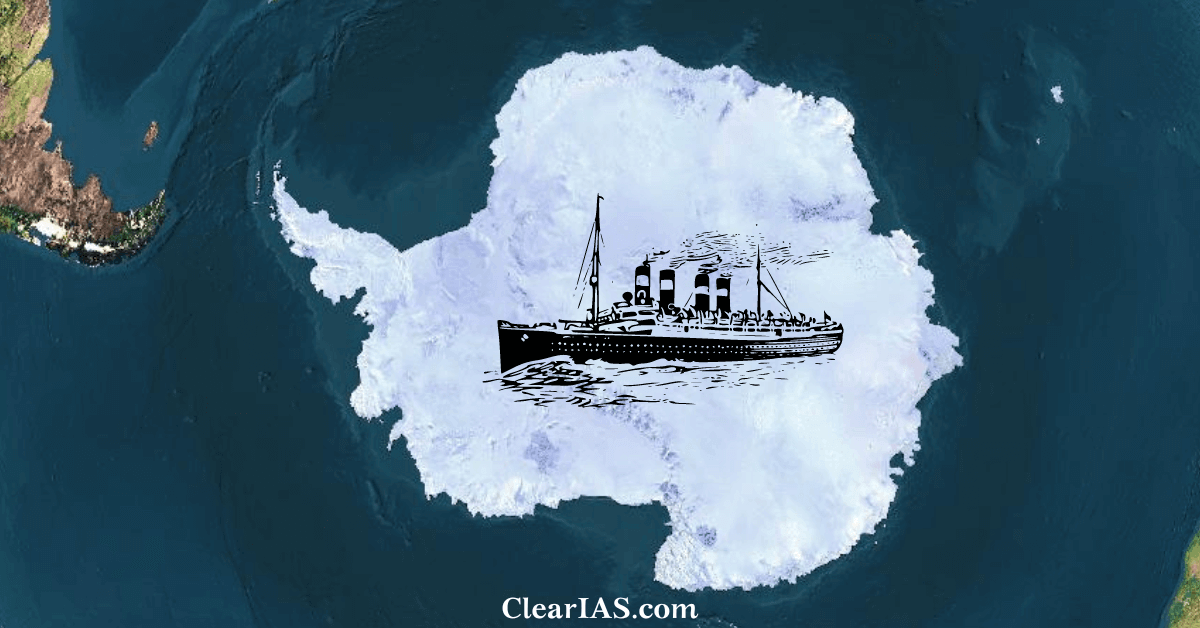
The Polar Code has been adopted by the International Maritime Organization(IMO) to ensure environmental protection and safe ship operations in polar zones.
The framework also covers safety, environmental protection, construction, equipment, operations, training, and rescue.
It is put into effect by amending international maritime treaties including SOLAS (International Convention for the Safety of Life at Sea), MARPOL ( International Convention for the Prevention of Pollution from Ships), and the STCW (International Convention on Standards of Training, Certification, and Watchkeeping for Seafarers). The Polar Code entered into force on 1 January 2017.
Certain ships traveling domestically or internationally in Arctic or Antarctic waters are subject to the Polar Code.
What are Polar Zones?
The term “polar zones” typically refers to the areas near the Earth’s poles, namely the North Pole and the South Pole. These regions are characterized by distinctive environmental conditions, including extreme cold temperatures, long polar nights, and polar days. The polar zones are divided into two main areas:
Arctic Zone (North Polar Zone):
- The Arctic Zone is located around the North Pole, within the Arctic Circle. This circle is an imaginary line at approximately 66.5 degrees north latitude.
- The Arctic experiences extreme cold temperatures, with ice-covered seas and tundra landscapes. During winter, the Arctic is in constant darkness for an extended period (polar night), while in summer, it has continuous daylight (polar day) for several months.
Antarctic Zone (South Polar Zone):
- The Antarctic Zone is situated around the South Pole, within the Antarctic Circle, an imaginary line at approximately 66.5 degrees south latitude.
- Antarctica, the continent at the South Pole, is characterized by vast ice sheets, glaciers, and a harsh climate. Like the Arctic, Antarctica experiences polar nights and polar days.
Key features of polar zones include:
- Extreme Cold: Both polar zones are known for their extremely low temperatures. The coldest temperatures on Earth are often recorded in these regions.
- Polar Ice: Large portions of the polar zones are covered by ice, including ice caps, glaciers, and sea ice. In Antarctica, the ice sheet contains a significant portion of the world’s fresh water.
- Unique Ecosystems: Despite the harsh conditions, polar zones support unique ecosystems adapted to cold environments. This includes specialized flora and fauna such as polar bears, Arctic foxes, penguins, and various cold-adapted plants.
- Seasonal Variations: The polar zones experience extreme seasonal variations in daylight due to the tilt of the Earth’s axis. This leads to prolonged periods of daylight during the summer and extended darkness during the winter.
- Importance for Climate: The polar regions play a crucial role in regulating the Earth’s climate. Changes in polar ice and temperature can have global implications, including sea level rise and shifts in weather patterns.
What is Polar Code?
The Polar Code is intended to cover the full range of shipping-related matters relevant to navigation in waters surrounding the two poles.
It includes ship design, construction, and equipment; operational and training concerns; search and rescue; and, equally important, the protection of the unique environment and ecosystems of the polar regions.
It also consists of mandatory measures covering safety part (part I-A) and pollution prevention (part II-A) and recommendatory provisions for both (parts I-B and II-B).
The polar code classifies vessels as:
- Category A ship – ships designed for operation in polar waters at least in medium first-year ice, which may include old ice inclusions
- Category B ship – designed for operation in polar waters in at least thin first-year ice, which may include old ice inclusions
- Category C ship – a ship designed to operate in open water or ice conditions less severe than those included in Categories A and B.
Ships need to carry a Polar Water Operational Manual, to provide the Owner, Operator, Master, and crew with sufficient information regarding the ship’s operational capabilities and limitations to support their decision-making process.
The chapters in the Polar Code each set out goals and functional requirements, including those covering ship structure; stability and subdivision; watertight and weathertight integrity; machinery installations; operational safety; fire safety/protection; life-saving appliances and arrangements; safety of navigation; communications; voyage planning; manning and training; prevention of oil pollution; prevention of pollution form from noxious liquid substances from ships; prevention of pollution by sewage from ships; and prevention of pollution by the discharge of garbage from ships.
Background
The safety of ships operating in the harsh, remote, and vulnerable polar areas and the protection of the pristine environments around the two poles have always been a matter of concern for IMO, and many relevant requirements, provisions, and recommendations have been developed over the years.
Trends and forecasts indicate that polar shipping will grow in volume and diversify in nature over the coming years and these challenges need to be met without compromising either the safety of life at sea or the sustainability of the polar environments.
Ships operating in the Arctic and Antarctic environments are exposed to several unique risks. Poor weather conditions and the relative lack of good charts, communication systems, and other navigational aids pose challenges for mariners. The remoteness of the areas makes rescue or clean-up operations difficult and costly. Cold temperatures may reduce the effectiveness of numerous components of the ship, ranging from deck machinery and emergency equipment to sea suctions. When ice is present, it can impose additional loads on the hull, propulsion system, and appendages.
The International Code of Safety for ships operating in polar waters (Polar Code) covers the full range of design, construction, equipment, operational, training, search and rescue, and environmental protection matters relevant to ships operating in the inhospitable waters surrounding the two poles.
Why do we need a Polar Code?
Enhanced Safety Standards:
The Polar Code establishes specific safety and environmental standards for ships operating in polar waters. This includes provisions for ship design, equipment, and crew training tailored to the unique conditions of the Arctic and Antarctic regions.
Mitigation of Environmental Risks:
The fragile ecosystems of the polar regions are particularly vulnerable to environmental damage. The Polar Code includes measures to reduce the environmental impact of shipping activities in these areas, such as restrictions on discharges and provisions for handling and managing potential spills.
Search and Rescue Coordination:
The code includes requirements for ships operating in polar waters to have appropriate search and rescue (SAR) arrangements. This is crucial given the challenging and remote nature of polar environments, where assistance may be limited.
Navigational Safety:
The Polar Code addresses navigational challenges associated with polar waters, including ice navigation. It sets guidelines for safe navigation, taking into account factors such as ice conditions, weather, and the availability of updated navigational charts.
Crew Training and Qualifications:
Recognizing the specialized skills required for operating in polar waters, the code outlines training and qualification requirements for crew members. This ensures that seafarers are adequately prepared for the challenges posed by polar navigation.
Vessel Design and Construction:
The code includes specific requirements for the design and construction of ships intended for polar operations. This encompasses considerations such as ice strengthening, hull design, and equipment to withstand the extreme conditions of polar environments.
Sustainable Development:
The Polar Code contributes to the sustainable development of polar regions by promoting responsible and safe shipping practices. This is particularly important as melting ice in the Arctic has opened up new shipping routes, increasing the potential for maritime activities in these areas.
International Cooperation:
The adoption of the Polar Code reflects international cooperation through the IMO. It provides a standardized framework that helps ensure a consistent and coordinated approach to safety and environmental protection in polar waters, involving nations with interests in these regions.
How does the Polar Code Protect the Environment?
- Prohibited the discharge of oil or oily mixtures from any ship into the sea.
- Double hull and double bottom required for all oil tankers
- Heavy fuel oil is banned in the Antarctic region
- Using non-toxic-biodegradable lubricants or a water-based system of lubricated components outside the underwater hull
- Measures to be taken to minimize the risk of invasive aquatic species through ships
- No discharge of sewage in polar waters
- Discharge is permitted if the ship has an approved sewage treatment plant, and discharges treated sewage as far as practicable from the nearest land, any fast ice, ice shelf, or areas of specified ice concentration
- Sewage not comminuted or disinfected can be discharged at a distance of more than 12nm from any ice shelf or fast ice
- Comminuted and disinfected sewage can be discharged more than 3nm from any ice shelf or fast ice
- All disposal of plastics prohibited
- Discharge of food wastes onto the ice is prohibited
- Discharge of animal carcasses is prohibited
- Cargo residues, cleaning agents, or additives in hold washing water may only be discharged if: they are not harmful to the marine environment
- Discharge of noxious liquid substances (NLS) or mixtures containing NLS is prohibited in polar waters
Many business organizations and environmental organizations criticized the 2014 Polar Code final draft as being “too weak” and “too diluted”.The polar code ignores numerous environmental and structural problems and does not cover the whole class of vessels. Fishing boats with less than 500 GT are exempt from the requirements of the code. The code makes no mention of air pollution and greenhouse gas emissions.
For more information: India’s Arctic Policy
Article written by Aryadevi






Leave a Reply